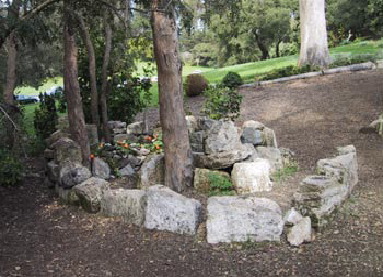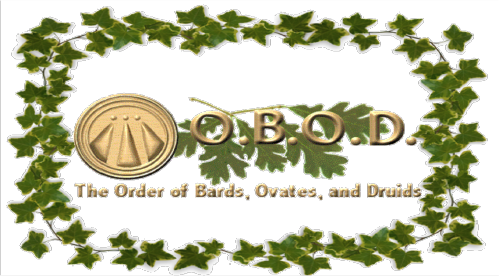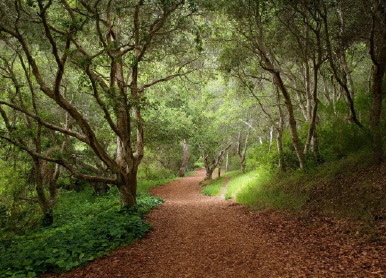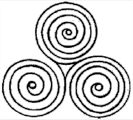
Did you know that your browser is out of date?
To get the best possible experience using our website we recommend that you upgrade your browser to a newer version. The upgrade to the software below is free.







Teachings of the Celtic Wheel of the Year
Celtic Shamanism, like all elder traditions, is cyclic and perennial rather than linear. It is like the wheel and in its higher forms like a spiral. There is no beginning or ending rather a circle or a spiral. Therefore group members may join a circle at any time and if they complete a year and a day from their beginning they will experience the full wheel of the teachings. If they continue beyond the year and a day, they will then begin to experience the teachings of the perennial spiral. Re-experiencing a second or more times the eight seasons of the year is like a spiral which moves to deeper levels of understanding of each season and each archetype.The wheel of the year is our primary and most important teacher. The wheel of the year is divided into 8 shifting seasons. All ancient cultures listened to and honored the seasons of the year. Those who did not essentially died. Those who listened prospered. It was just that simple.
Megalithic sites like Stonehenge, and in ancient Egypt and New Grange were created as a type of a computer to define the beginnings and endings of the seasons and their rhythmical cycles. Ancient people knew it was important to be in harmony and unity with the rest of nature and its cycles. Mankind in the last 250 years has separated itself from the cycles of nature, to the extent of which we have caused much havoc and destruction.
It is the purpose of Shamanism world wide and of the earth based traditions of indigenous peoples to help modern humans reconnect to nature, and the cycles of the year and the cosmos. It is the belief of Shamanistic philosophy that people are suffering major soul- loss due to their almost complete separation from nature. In Shamanistic traditions, it is believed necessary that we must connect with the land in order to understand and be in harmony with the balance of life on the earth where we are.
Therefore Shamanistic traditions vary according to locality and cannot be like modern religions like Christianity and Judaism, etc. and be applicable the same in all parts of the worlds. RJ Stewart has pointed out that one of the problems with Christianity for example, is that it is a tradition that was developed in a desert environment and is therefore not in harmony in an environment where there are forests for example. Unlike Native American philosophies that were evolved in areas where there were forested areas there is built into the spirituality the idea that trees are sacred and are to be preserved. . Unlike Christianity that developed in a desert environment where trees were not important. Also, being developed in a nomadic tradition, the importance of location was not as prominent as for example , the Native American people of the San Francisco area, the Olone who had resided here for over 5000 years.
In all earth based indigenous spiritual traditions worldwide, the wheel of the year , and the sacred directions and elements are present. However, there is a great diversity worldwide in the associations with particular elements and particular directions and seasons of the year. This seems confusing on the surface, yet when you look deeper it makes sense because indigenous spiritualities are based upon localities that are different, in their particular aspects.
For example in the Celtic/Northern European tradition, the direction of the North is associated with Earth and Stone Because Mountains are to the North, The Element of Water is associated with the West because the Ocean is to the West, The element of the Air is associated with the East. The element of fire is associated with the south because the south is where the warmer climates and temperatures are. In Northern American Traditions this works the same because the geographical topographical is the same. But the East coast Native Americans have east and west reversed because the Sea is to the East and the Forests are to the West. In a similar vein, the wheel of the year involving the eight scared seasons is applicable for land that are in the Northern Hemisphere, but have to be totally shifted when we go to Australia or other locations in the Southern Hemisphere because the seasons are reversed. For example, in North America the season of Beltaine begins on May 1, and is the beginning of Summer. Whereas in Australia, May first is not the beginning of summer. It is the beginning of winter, and therefore it is Samhain.
Therefore, practitioners of Earth based tradition if they are practicing the spirit of the tradition rather than concrete calendar dates, must do their work in harmony with the environment where they are. It makes no sense to be doing a festival of Beltaine on May 1st, if you live in Australia. In ancient times the 8 festivals of the year are determined by actual events in nature and the cosmos of starts moon and sun. Astronomy developed as a means of determining the beginnings and endings of each season. Modern man has become lazy and linear and most modern pagans therefore celebrate the ancient holidays based on linear dates rather than the ancient way of determining holidays which is based upon material, natural, physical reality and earth-based phenomena. In addition Modern man looks upon the festivals as a particular date, such as Samhain, rather than the ancients did, which is as a season. Also the season is not just external, i.e, what is going on outside of self, but also internal, --what is going on internally based on what is happening to out internal bodies, physical, spiritual, and emotionally.
A good deal of physical, emotional and spiritual ill health is due to human beings functioning as if there is no external season or internal season, and being totally disconnected from nature. The expectation that we get up at 7 am and go to work 9 to 5 Summer, Fall, Spring, Winter the same is an example of insanity and disconnection. . Agrarian peoples shifted their activity levels according to the season. And may work 14 hours in summer and may work only 3 or 4 hours per day in winter.
It is now noted that a number of people experience a good deal of depression as we approach winter and have less light. It is the opinion of shamans that the coming of emotional depression is not the result of the absence of light, but rather because of attempting to continue summer levels of activities during the winter season, we get physically sick and depressed because we are not able to be quiet and inward as the cycle of the year calls upon us to be. It is the purpose of the Jungian shananistic groups to help modern people to become connected to the 8 seasons of the year both externally and internally. Then, to harmonize one's life behavior and activities with these 8 seasons, thereby creating greater connectedness and creating greater physical, emotional and spiritual health.
We will now go through the 8 seasons of the year and look at them and what the group's do and focus upon in each of the seasons in order to understand and connect with the seasons both externally and internally. We want to emphasize that we are dealing with the Northern Hemispheric traditions, of Northern Europe and the Western half of North America as relates to the elements. This system is common to the entire Northern hemisphere for seasons, but not elements. The Southern hemisphere is opposite. An example was cited from a person from the country of Chile, who noted that he had seen Catholic Nuns wearing their heavy clothing were going out to cemeteries to honor the dead on November 1st even though that was the warm beginning of summer. This is another example of people not being in touch with local seasons and local peoples.
Ancient cultures were very individuated to each place on the Earth and people, including their own individuated versions of God/Goddess etc./ Monotheistic religions have discounted and taken away indigenous peoples unique spirituality which was developed by them and for them in their own particular land and place (over vast periods of time). This is an example why indigenous people are averse to other people taking away their religious practices and trying to incorporate them into different location and geographical conditions with people of different cultures. In Ireland, and many places people have adapted their Christianity to their locality, and therefore you find many local festivals that are incorporated into Christian rituals. In Jungian terms the shamanic memory is imprinted on our psyches at a much deeper level than any modern religion that may have been imposed upon our ancestry even for say 2 thousand years. It is our strong belief that when we do practices that are hundreds of thousands of years old, we remember. Therefore when we do ritual we are reawakening and reconnecting to our ancestral memories.
A Year and A Day
In elder traditions a year and a day was a period of initiation and completion. After completing this circle, this wheel, this year and a day; the student moves into a new phase of learning. This new phase is symbolized by the spiral rather than the circle. After completing the wheel of the year we spiral into the next level. We begin the next wheel but it is a spiral based upon the previous cycle. It is a higher level. The next wheel be experienced holistically because we’ve experienced the full cycle and now we get to experience it rather than as separate spokes of the wheel but as the whole wheel. Each of the festivals is like a spoke in a wheel; in our first circling through the festivals we experience them as separate. During the second experience of the wheel of the year we experience the spokes as being part of the whole—the wheel. We come to realize that each festival creates and leads into the next. The experience of each festival is different and higher when we experience as part of a whole rather than a separate experience. This work helps us to begin to experience ourselves as well as everything else in the universe as connected and part of a whole rather than separate, discrete entities. This spiral process therefore, results in the combined deepening, broadening and elevating of experience through each yearly cycle.
The 8 Seasons of the Celtic Wheel of the Year
In Celtic Shamanistic Traditions, each of the different directions has different elemental and energetic and behavioral associations.
Begining about Nov. 1st -- Samhain is the Pagan New Year. It literally means "summer's end" in Irish Gaelic, and is the hallmark of the feminine half of the year. It is the time we honor those beloved who have died, particularly in the last year.
Yule is the celebration of the rebirth of light. It is humanity's oldest celebration which honors the Goddess giving birth to her son - the God, the Sun, and the Light.
February 1st - Brighid honors the time just before spring, when the earth is preparing to burst forth in productivity. It is the time when ewe's milk begins to flow in preparation for birthing, a symbol of the mother's milk of the earth.
Marks the shift from the lethargy and darkness of winter into the fruitfulness of Spring. The festival honors the time for new beginnings, as we travel into the light and action of spring, in gratitude for its warmth and light.
May 1st - Beltaine is the hallmark of the male part of the year, and honors the fecundity of earth. The God and Goddess are in sexual union - the maypole represents the phallus of the God planted in the Earth Goddess. The plants and flowers we lash to the maypole with ribbons represent the fertility of the Goddess. The festival celebrates vitality and passion - we cherish the joys life has to offer.
A festival in honor of the sun, of passion, and of the ripeness of the earth. The Goddess and the earth are heavy with pregnancy. This is a time when sacred and magical plants are gathered, dried, and stored for the coming winter.
August 1st - A time of thansgiving for the first fruits of the harvest. The God, a metaphor for the grain, is sacrificed - cut down in the fields to feed us. We make offerings of gratitude, ever mindful of the bounty the earth provides.
The light and darkness again are equal, but light grows less. The God, sacrificed in the harvest to nurture us, begins his journey into the Underworld. Mabon is a celebration of the completion of the harvest begun at Lughnasadh.